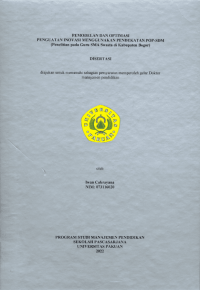Disertasi MP
Permodelan dan Optimasi Penguatan Inovasi Menggunakan Pendekatan POP-SDM (Penelitian pada Guru Swasta di Kabupaten Bogor)
The results of this study concluded that: (1) There is a positive direct influence of professional commitment to innovation with a value of yx1 = 0.292, (2) There is a positive direct influence of pedagogical competence on innovation with a value of yx2 = 0.099, (3) There is a positive direct influence on the effectiveness of training on innovation with a value of yx3 = 0.138, (4) There is a positive direct influence of achievement motivation on innovation with a value of yx4 = 0.362, (5) There is a positive direct influence of technological literacy on innovation with a value of yx5 = 0.098, (6) There is a positive direct influence of professional commitment to the motivation of achievement with a value of x 4 = 0.582, (7) There is a positive direct influence of pedagogical competence on technological literacy with a value of x 5 x2 = 0.375, (8) There is a positive direct influence on the effectiveness of training on technological literacy with a value of x 5 = 0.123, (9) There is a positive indirect influence of professional commitment to innovation with t hitung value = 7,172, (10) There is a positive indirect influence of pedagogical competence on innovation with t hitung value = 2,340, (11) There is a positive indirect influence on training effectiveness to innovation with t hitung value = 1,938. The results of the SITOREM analysis show that the indicators that are still weak and need to be improved are: 1) Goals to be achieved, 2) The need to succeed in a career, 3) The obligation to remain in the organization, 4) The weight of leaving the organization, 5) Benefits if it survives, 6) Design of training programs, 7) Implementation of training, 8) Ability to manage learning, 9) Utilizing information and communication technology, 10) Understanding learners, 11) Ability to develop the potential of learners, 12) Conduct assessment and evaluation of learning processes and outcomes, 13) Ability to understand hardware, 14) Ability to use hardware, 15) Ability to use software, 16) Ability to use technology concepts, 17) Product development, 18) Creation of new services, 19) Service development.
Ketersediaan
Informasi Detail
- Judul Seri
-
-
- No. Panggil
-
26/CAK/D.MP/2022
- Penerbit
- Bogor : SPS Unpak., 2022
- Deskripsi Fisik
-
iii, 507 hlm; ilus 21 x 29 cm
- Bahasa
-
Indonesia
- ISBN/ISSN
-
-
- Klasifikasi
-
26/CAK/D.MP/2022
- Tipe Isi
-
-
- Tipe Media
-
-
- Tipe Pembawa
-
-
- Edisi
-
-
- Subjek
- Info Detail Spesifik
-
-
- Pernyataan Tanggungjawab
-
Prof. Dr. Ing. H. Soewarto Herdhienata dan Dr. H. Oding Sunardi, M.Pd
Versi lain/terkait
Tidak tersedia versi lain
Lampiran Berkas
Komentar
Anda harus masuk sebelum memberikan komentar

 Karya Umum
Karya Umum  Filsafat
Filsafat  Agama
Agama  Ilmu-ilmu Sosial
Ilmu-ilmu Sosial  Bahasa
Bahasa  Ilmu-ilmu Murni
Ilmu-ilmu Murni  Ilmu-ilmu Terapan
Ilmu-ilmu Terapan  Kesenian, Hiburan, dan Olahraga
Kesenian, Hiburan, dan Olahraga  Kesusastraan
Kesusastraan  Geografi dan Sejarah
Geografi dan Sejarah